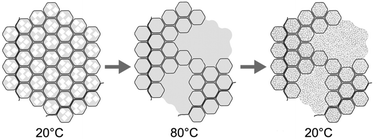Temperature-dependent properties of fat in adipose tissue from pork, beef and lamb. Part 1: microstructural, thermal, and spectroscopic characterisation†
Abstract
We investigated the temperature-dependent microstructure and thermal properties of back fat adipose tissue from pork, beef and lamb. Microstructural characterisation via electron, confocal and light microscopy showed that the back fats were structurally similar and consisted of fat dispersed as discrete units within a protein matrix akin to a closed cell foam. Differential scanning calorimetry showed distinct fat melting profiles for each of the tissues, which were ascribed to differences in fatty acid profile. Fat crystal organisation, melting and re-solidification signatures unique to each adipose tissue were found via X-ray diffraction and Raman spectroscopy. Overall, we found that the temperature-dependent microstructure of adipose fat was intricately linked to the fat phase melting behaviour, and importantly, to its protein matrix at elevated temperatures. Such understanding is necessary to provide the required insights to effectively replicate the functionality of adipose tissue using plant-based materials.



 Please wait while we load your content...
Please wait while we load your content...